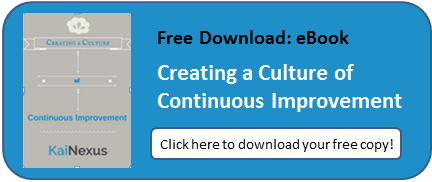 Some of the world’s largest and most successful organizations, including GE, Toyota, and Amazon have implemented sophisticated business process management methodologies like Six Sigma, Lean Manufacturing and Kaizen. A central theme that runs through all of them is the idea of continuous improvement. Each methodology looks for ways to improve products, processes and profitability while delivering value to the customer. Whether or not you choose to use one of these approaches, you can still achieve rapid continuous improvement for your business if you keep these core concepts in mind.
Some of the world’s largest and most successful organizations, including GE, Toyota, and Amazon have implemented sophisticated business process management methodologies like Six Sigma, Lean Manufacturing and Kaizen. A central theme that runs through all of them is the idea of continuous improvement. Each methodology looks for ways to improve products, processes and profitability while delivering value to the customer. Whether or not you choose to use one of these approaches, you can still achieve rapid continuous improvement for your business if you keep these core concepts in mind.
Identify Opportunities for Improvement
The first step in rapid continuous improvement is identifying an opportunity for improvement. This can be an inefficient process, a safety risk, a product flaw or anything else that could benefit from a positive change. The biggest mistake organizations make regarding the identification of these opportunities is assuming that the executive team is in the best position to find them, when in fact, the opposite is usually the case. Front line employees often have much better visibility into the challenges that hinder operational excellence. They have deeper insight into business processes, tools, and the customer experience. Looking to everyone in the organization for improvement ideas is central to accelerating forward progress.
Apply An Effective Implementation Workflow
Once an opportunity for improvement is identified, there must be a structure in place to consider improvement alternatives, decide on a course of action and manage the implementation process. Technology designed to support this process should come equipped with automated alerts and notifications, and it should support both top-down and bottom-up workflows.
Measure Improvement Impact
For rapid continuous improvement, it is essential that the results of each improvement be measured, so that the impact can be understood in terms of improved quality, enhanced safety, cost reduction, revenue generation, time savings, and improved customer satisfaction. Impact measurement will help keep the organization energized about the improvement initiative, as well as help inform decisions on future improvement projects.
Foster Employee Engagement
The impact of employee engagement on rapid continuous improvement cannot be understated. Every team member is a valuable asset in identifying and resolving improvement opportunities. Engagement can be enhanced with solutions that create transparency and broadcast success. Recognizing and rewarding employees who contribute ideas and work to implement them is the most effective way to get more employees involved and excited about organizational improvement.
Achieving rapid continuous improvement isn’t impossible, but it won’t happen on its own. It requires a defined structure, the right cultural shift and commitment from leadership. Organizations that do it well enjoy efficient processes, satisfied employees, happy customers and ultimately, the best long-term bottom line performance.



Add a Comment